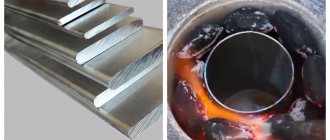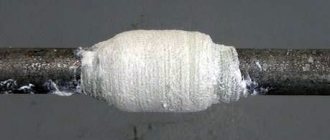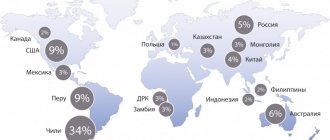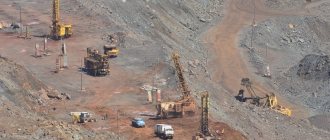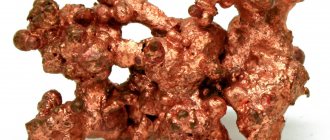Characteristics of bauxite
In color they are most often red, brown, less often white, gray, black, green or with admixtures of various colors. Bauxite does not dissolve in water. Externally they may look clayey or rocky, their structure may be dense or porous, finely crystalline or amorphous. Density depends on iron content. Often rounded grains formed by alumina or iron oxide may be included in the groundmass. With a content of 50-60% iron oxide, the rock acquires the meaning of iron ore. The hardness of bauxite on the Mohs scale ranges from 2 to 7. Its chemical formula, in addition to aluminum oxide hydrates that make up the main ore mass, includes iron, silicon, titanium, magnesium and calcium carbonate, phosphorus, sodium, potassium, zirconium, vanadium in the form of various compounds . Sometimes - an admixture of pyrite.
Bauxite does not dissolve in water
Depending on the nature of the rock-forming mineral, bauxite can be divided into 3 main groups:
- monohydrate, in which alumina is presented in only one form (diaspore, boehmite);
- trihydrate, containing alumina in trihydrate form (gibbsite);
- mixed, combining the first 2 groups.
The quality and grade of bauxite as aluminum ore depends on the content of aluminum oxide in terms of dry matter. The highest brand contains it in the amount of 52%, the lowest brand contains at least 28%. Even within the same deposit, the amount of alumina can vary significantly. The quality of the rock decreases with increasing silicon oxide content.
Bauxite ore is valued, from which alumina is easily extracted. Its different varieties and brands are used in industry in their own way.
Automotive industry
Governments around the world are setting increasingly stringent carbon emissions standards for cars. From 2010 to 2020, average carbon dioxide emissions were expected to fall from 142 g/km to 95 g/km, a reduction of 3.9% annually.
Aluminum can reduce the weight of the corresponding part by more than 50% compared to competing materials. For niche models with an all-aluminum body, weight savings reach 30-40%, from 70 to 140 kg, depending on the size of the car.
Major US automakers such as Ford and troublemakers such as Tesla are focusing on using aluminum to reduce the weight of their vehicles to improve performance and safety. The well-known American industry standards CAFE require an increase in mileage per 1 liter of fuel from 2011 to 2025 of at least two times. Therefore, automakers have virtually no choice but to reduce the weight of their cars. Aluminum will play a major role in solving this problem.
India
Vibrant India is in seventh place. The country's area is 3.2 million km². The state is one of the fastest growing powers and is a potential superpower.
The country is washed by the waters of the Indian Ocean and the Arabian Sea. The country has many rivers that are characterized by a sharp seasonal rise in water, which leads to floods. The largest rivers are the Brahmaputra and the Ganges.
The state has significant reserves of metals, including gold, iron ores, and aluminum. Also in its depths there are precious stones, copper, oil, and coal. The country occupies a leading position in the world in the production of sheet muscovite.
India has a rich, diverse culture and is the birthplace of tea, Buddhism and Hinduism. Cultural ancient traditions are revered here. Family values are respected in society. The most famous architectural landmark of the country is the Taj Mahal monument. There are many historical shrines and temples in the country. In India, white is considered the color of mourning. The most popular game here is cricket.
Photo: pixabay.com
Leading countries in aluminum ore production
The main deposits of aluminum are concentrated in regions with a tropical climate, and most of the 73% of deposits are found in just 5 countries: Guinea, Brazil, Jamaica, Australia and India. Of these, Guinea has the richest reserves, more than 5 billion tons (28% of the world share).
If we divide reserves and production volumes, we can get the following picture:
- 1st place – Africa (Guinea).
- 2nd place - America.
- 3rd place – Asia.
- 4th place – Australia.
- 5th – Europe.
The top five countries in aluminum ore production are presented in the table
| A country | Production volumes million tons |
| China | 86,5 |
| Australia | 81,7 |
| Brazil | 30,7 |
| Guinea | 19,7 |
| India | 14,9 |
Also, the main producers of aluminum ores include: Jamaica (9.7 million tons), Russia (6.6), Kazakhstan (4.2), Guyana (1.6).
Aluminum resources and reserves
Resources of aluminum raw materials (bauxite and alunite) are known in 95 countries. According to the US Geological Survey, the world's resources of bauxite are the main raw material of the aluminum industry, estimated at 55-75 billion tons, the resources of aluminum raw materials in general are 83 billion tons.
Some modern analysts consider this estimate to be too low. 72% of the world's bauxite reserves are concentrated in giant, 23% in large and 5% in medium and small bauxite provinces. More than 90% of the world's total bauxite reserves are concentrated in 18 countries with tropical or subtropical climates. Guinea (20 billion tons) has unique reserves, and Australia (6.71 billion tons), Brazil (6.11 billion tons), Vietnam (3.0 billion tons), India (2. 53 billion tons), Indonesia (2.13 billion tons). These six countries contain 63% of the total bauxite reserves.
Bauxite
56 countries have proven bauxite reserves, and 18 of them contain more than 90% of these reserves. The largest confirmed reserves are in Guinea (20.8% of the world), Brazil (14.6%), Australia (11.3%), Jamaica (7.4%), Cameroon (6.1%), Mali (4.5 %). They contain 65% of the world's proven bauxite reserves.
Bauxite reserves at the turn of the 20th-21st centuries. (million tons)
| Continents | Inventory Confirmed | Share in the world, % | General reserves |
| Europe | 1483 | 5,5 | 2188 |
| Asia | 3641 | 13,6 | 11068 |
| Africa | 10215 | 38 | 28450 |
| America | 8215 | 30,6 | 14802 |
| Australia and Oceania | 3111 | 11,6 | 6863 |
| together | 26865 | 100 | 64045 |
The annual level of aluminum consumption in the world is 24 million tons. It is estimated that by 2010, the consumption of aluminum and products made from it in the automotive industry will double, in the production of containers and packaging by more than 65%. The annual increase in aluminum consumption in the global economy will be 3-5%.
Place of Birth
About 90% of the world's bauxite reserves are located in 18 tropical countries. Typically, the quality of lateritic bauxites formed as a result of deep chemical processing of aluminosilicate rocks in tropical climates is high. Sedimentary bauxites formed as a result of the transfer of lateritic weathering products and their redeposition can be either high-grade or substandard. Deposits are located in the form of layers, lenses or nests, often on the surface of the earth or in its uppermost layers. Therefore, ore is mainly mined in open pits using powerful mining equipment. World reserves are characterized by uneven territorial distribution. More than 50 countries have ore deposits, with 93% of these reserves located in 12 of them. Large deposits have been discovered in Australia, Africa, South and Central America, Asia, Oceania, and Europe. The highest alumina content is in ore mined in Italy (64%) and China (61%).
Gallery: bauxite stone (50 photos)
Russia's largest bauxite deposits are located in Severouralsk , where 70% of the country's total ore is mined. These are the oldest deposits on earth, more than 350 million years old. The recently commissioned Cheremukhovskaya-Glubokaya mine is located 1,500 m underground. Its uniqueness is in the extraction and transportation of ore: 1 piledriver contains 3 lifting machines. Proven reserves amount to 42 million tons, and the aluminum content of the ore is almost 60%. The Cheremukhovskaya mine is the deepest in the Russian Federation. It should meet the country's need for aluminum for 30-40 years.
The cost of 1 ton of ore without transportation costs in Russia is 20-26 dollars, for comparison, in Australia -10. Due to unprofitability, bauxite mining has been stopped in the Leningrad and Chelyabinsk regions. In Arkhangelsk, rock with a high level of alumina is mined by open-pit mining, however, the increased content of chromium and gypsum reduces its value.
The quality of ores from Russian deposits is inferior to foreign ones, and their processing is more complicated. Russia ranks 7th in the world in bauxite production.
Development of aluminum ore deposits in Russia
In our country there are several rich deposits of aluminum ores, concentrated in the Urals and in the Leningrad region. But the main method of extracting bauxite in our country is the more labor-intensive closed mine method, which extracts about 80% of the total mass of ores in Russia.
The leaders in deposit development are the joint-stock company Sevuralboxitrude, JSC Baksitogorsk Alumina, and the South Ural Bauxite Mines. However, their reserves are running out. As a result, Russia has to import about 3 million tons of alumina per year.
| Field | Reserves |
| Little Red Riding Hood (Ural) | For 19 years of production |
| Gornostayskoye and Gornostaysko-Krasnooktyabrskoye | For 18 years of production |
| Blinovo-Kamenskoye | 10 years |
| Kurgazskoe | 10 years |
| Radynsky quarry | 7 years |
In total, 44 deposits of various aluminum ores (bauxite, nepheline) have been explored in the country, which, according to estimates, should be enough for 240 years, with such mining intensity as today.
The import of alumina is due to the low quality of the ore in the deposits, for example, bauxite with a 50% alumina composition is mined at the Red Cap deposit, while in Italy rock with 64% aluminum oxide is extracted, and in China 61%.
World bauxite reserves
In 1974, there were approximately 19 billion tons of this ore on Earth. True, the scientists’ assessment had errors, since it did not include the huge Soviet Union. At that time, there were only 5.2 billion tons of reliable proven reserves.
In the first decades of the last century, almost all bauxite was mined in developed countries. And today work is underway there, for example, in Italy and France. Although there is little stone in Europe - a maximum of 7% of world reserves. These minerals are also scarce in the United States.
In the 60s, states from the Caribbean Sea became leaders: Guyana, Jamaica, Suriname. Today, the main countries in production are Guinea, Australia, Brazil and some other countries. There are bauxites in Russia too. Deposits have been discovered, for example, in the Urals and the Komi Republic.
Main reserves of explored bauxite
Reserves in thousand tons
In total, the world's proven reserves of bauxite amount to more than 30 billion tons, which should be enough for many centuries. The TOP 5 have more than 70% of the world's bauxite reserves.
Aluminum (bauxite) is included in the list of 35 critical minerals compiled by the US Department of the Interior
Aluminum production requires a very large amount of electricity. Fortunately, bauxite is a transportable raw material. As a result, the geography of bauxite production and consumption varies markedly. The main consumers of bauxite are developed countries with a good energy base (as a rule, aluminum smelters are clustered near hydroelectric power stations). Thus, the territorial gap between the stages of aluminum production increases noticeably.
Australia is the leader in bauxite mining (75 million tons), followed by China (70 million tons) and Guinea (50 million tons).
Source
Use of bauxite
The use of bauxite accounts for 60% of aluminum production. Its production and consumption ranks 1st in the world among non-ferrous metals. It is necessary in shipbuilding, aviation and food industries. When using aluminum profiles at sea, their strength, lightness and corrosion resistance are of great importance. The consumption of bauxite in construction is developing dynamically; more than 1/5 of the aluminum produced is spent on these needs. When smelting ore, electrocorundum is obtained - an industrial abrasive. The released impurity residues of non-ferrous metals are raw materials for the production of pigments and paints . Alumina obtained from ore is used as a molding material in metallurgy. Concrete made with the addition of aluminous cement hardens quickly and is resistant to high temperatures and liquid acidic environments. The absorbent properties of bauxite make it suitable for use in oil spill removal products. Low-iron rocks are used to make refractories that can withstand temperatures up to 1,900°C.
The demand for aluminum and other ore processing products is growing, so developed countries are investing in the development of deposits even with a low profitability threshold.
The use of bauxite in jewelry is found only in original works. Unusually colored specimens are used to make souvenirs, in particular polished balls. The mineral bauxite is not used in folk medicine, since its therapeutic potential has not been discovered to date. Also, its magical properties have not been identified, so it does not attract the attention of psychics.
Leading countries in the world in aluminum production and smelting
Hello, dear readers of the Tyulyagin project! Today we will talk about aluminum. In the article you will learn why aluminum is smelted and where it is used. But, mainly, the article will focus on comparing different countries in the production and smelting of aluminum. In the article you will find out which country is the largest aluminum producer in the world , as well as the largest exporters and importers of aluminum in the world . In addition, we will talk about the smelting of primary aluminum in Russia. Here you will find unique statistics on aluminum smelting in the USSR and Russia since 1932. Make yourself comfortable and enjoy reading.
The content of the article:
Dynamics of aluminum production by year in the USSR and Russia since 1932
Above I attach a graph with unique statistics on aluminum smelting in the USSR and Russia since 1932. It was in 1932 that aluminum production began in the country. Until now, aluminum was only imported. Imports of aluminum were also high during the Second World War; at that time, our own capacities were still not enough, and aluminum was actively imported from foreign countries, including the USA, Great Britain and Canada. However, aluminum production grew rapidly in the post-war years. By the end of the 1980s, primary aluminum smelting in the USSR reached 3.5 million tons. Like other industries, after the collapse of the USSR, the production of non-ferrous metals in Russia decreased. This happened in the flesh until 1995. Then the smelting of primary aluminum began to grow and by 2004 Russia exceeded the record smelting of the USSR. Despite this achievement, in recent years, aluminum smelting in Russia has begun to decline, reaching its peak in 2008 at 4.19 million tons; smelting at the end of 2021 amounted to only 3.6 million tons.
What is aluminum produced for and where is it used?
Aluminum is a lightweight metal. Aluminum is the most abundant metal in the world. Due to its lightness, strength, functionality and resistance to corrosion, aluminum has become popular and is used in many structures.
If you look closely, you can find aluminum almost anywhere you go. It is used in homes, in transport, in various equipment, including mobile phones and computers, and in other household items - refrigerators, microwaves, furniture and so on.
However, the use of aluminum was minimal a hundred years ago. And 200 years ago they knew little at all about metal. Aluminum occupies about 8% of the entire earth's crust and is the third most abundant element after oxygen and silicon. Despite its prevalence, aluminum is not found in nature in its pure form, which is why it was practically not used for a long time. Aluminum was first produced only in 1824, and only 50 years later it began to be actively used in industry.
Aluminum is three times lighter than iron, but is almost as strong as steel, and in addition is ductile. It is not magnetic and conducts electricity. Capable of forming alloys with almost all other metals.
All these properties have allowed aluminum to become the most popular metal for humans. This metal is used in all modern and high-tech industries - construction, automotive, energy, aviation, food, and space. It is also used in modern electronic technology, shipbuilding and other industries.
Rating of world countries for aluminum production and smelting for 2020
Since 2002, the leader in aluminum smelting in the world has been China . Today China smelts more than half of the world's aluminum production. At the end of 2021, China smelted 36,000 thousand tons , while 64,000 thousand tons of aluminum were produced worldwide. Following China are India and Russia ; they smelt approximately equal amounts of aluminum per year - 3,700 and 3,600 thousand tons, respectively.
For a long time, the United States was the leader in aluminum production in the world, until 2000. Today they are only at the end of the top ten with primary aluminum production at about 1,100 thousand tons. A complete list of countries by primary aluminum smelting can be found in the table below. USGS (United States Geological Survey) data was used as the main source of statistics.
| Rank | A country | Aluminum smelting, thousand tons | Year |
| World | 64000 | 2019 | |
| 1 | China | 36000 | 2019 |
| 2 | India | 3700 | 2019 |
| 3 | Russia | 3600 | 2019 |
| 4 | Canada | 2900 | 2019 |
| 5 | UAE | 2700 | 2019 |
| 6 | Australia | 1600 | 2019 |
| 7 | Bahrain | 1400 | 2019 |
| 8 | Norway | 1300 | 2019 |
| 9 | USA | 1100 | 2019 |
| 10 | Saudi Arabia | 916 | 2017 |
| 11 | Iceland | 870 | 2018 |
| 12 | Malaysia | 760 | 2017 |
| 13 | South Africa | 716 | 2017 |
| 14 | Brazil | 660 | 2018 |
| 15 | Qatar | 650 | 2017 |
| 16 | Mozambique | 577 | 2017 |
| 17 | Germany | 550 | 2017 |
| 18 | Argentina | 433 | 2017 |
| 19 | France | 430 | 2017 |
| 20 | Spain | 360 | 2017 |
| 21 | Iran | 338 | 2017 |
| 22 | New Zealand | 337 | 2017 |
| 23 | Romania | 282 | 2017 |
| 24 | Egypt | 279 | 2017 |
| 25 | Kazakhstan | 256 | 2017 |
| 26 | Oman | 253 | 2017 |
| 27 | Indonesia | 219 | 2017 |
TOP 10 aluminum producing countries
Today scientists know about 300 types of aluminum compounds. The main feature is wear resistance and the ability to be processed without loss of quality. Many countries are engaged in the extraction and smelting of aluminum.
USA
Metal production in the USA is in jeopardy due to the unprofitability of maintaining technical premises. Today, only seven companies operate throughout America. At the same time, the country still remains on the list of leaders in production. Thus, 910 thousand tons were smelted last year.
Saudi Arabia
Due to the increase in demand for metal, the government of Saudi Arabia is considering the option of developing this industry by opening new factories. Most of the material produced is used within the state. A smaller part is spent on sales to other countries. In 2021, 936 thousand tons of metal were produced.
Bahrain
The end of last year showed how rapidly the amount of metal produced in Bahrain is increasing. It is planned that in 2021 the figures will increase by 20%. At the same time, 1,115 million tons were produced in 2021.
Norway
Factories of other countries, for example, Germany, Denmark, Brazil, etc., are located on the territory of the state. Production indicators for last year, according to statistical data, were as low as possible and led to large losses. Despite this, Norway remains on the list of leading countries, producing an average of 1,640 million tons per year.
Australia
Aluminum production in Australia is gradually increasing every year, occupying a leading position in the list of producers. According to the Australian Department of Industry, 2021-2021 will be a consistently high year in terms of performance. On average, production will be 1,680 million tons per year.
United Arab Emirates
The UAE has expanded significantly in scale over the past decades. At the same time, developing within the state, its influence on the global industrial market increases. The largest metal production company, Emirates Global Aluminum (EGA), showed good results last year, producing 2,940 million tons of aluminum.
Canada
Despite the conflict between the union of the Canadian aluminum smelter Aluminerie de Becancour (ABI) and American shareholders, metal production was almost at full capacity last year. By the end of 2021, it is planned to fully resume all sectors of the enterprise and increase the result by at least 5%. So, last year, a plant in the province of Quebec produced 3,200 million tons of metal.
India
Vedanta Group, an aluminum manufacturing company in India, plans to begin construction of a new plant in the fourth quarter of 2021. Today, India is one of the three world leaders in providing other countries with metal. Last year, 3,540 million tons were produced.
Russia
Most of the aluminum production enterprises in the Russian Federation are located in Siberia. The exported portion increased by 13% compared to last year. The total amount of aluminum produced was 3,620 million tons.
China
At the end of the first quarter of 2021, aluminum production in China fell by 2%. At the same time, without in any way affecting its leading position in the world. At the end of last year, according to RUSAL, China produced 35 million 710 thousand tons. With such indicators, no country can come close to China in terms of production volume.
Source
Leading countries in aluminum export and import
As I already wrote, aluminum today is used in many industries, in connection with this, not only its smelting is developed, but also trade. Countries around the world actively export and import aluminum for their own needs.
Thus, the largest exporter of aluminum in the world at the beginning of 2021 is Canada . In dollar terms, Canada exported more than $5.3 billion worth of aluminum. Also among the top five largest aluminum exporters in the world are the Netherlands, the UAE, Russia and India. You can see the full list of aluminum export countries
| № | A country | Aluminum exports, million $ |
| 1 | Canada | 5349 |
| 2 | Netherlands | 5115.8 |
| 3 | UAE | 5113.2 |
| 4 | Russia | 4640.9 |
| 5 | India | 3819.7 |
| 6 | Norway | 2802.1 |
| 7 | Australia | 2775.2 |
| 8 | Malaysia | 2003.2 |
| 9 | Bahrain | 1931.5 |
| 10 | Iceland | 1429.3 |
| 11 | Qatar | 1291.6 |
| 12 | China | 1100.5 |
| 13 | USA | 1050.4 |
| 14 | South Africa | 1009.7 |
| 15 | Saudi Arabia | 967.8 |
| 16 | Germany | 957.7 |
| 17 | Mozambique | 940.3 |
| 18 | Italy | 751.1 |
| 19 | New Zealand | 652.9 |
| 20 | France | 578.2 |
| 21 | Spain | 574.9 |
| 22 | Great Britain | 516.6 |
| 23 | Kazakhstan | 513.3 |
| 24 | Poland | 466.6 |
| 25 | South Korea | 445.5 |
| 26 | Slovakia | 385.1 |
| 27 | Slovenia | 372 |
| 28 | Sweden | 362 |
| 29 | Austria | 323.2 |
| 30 | Oman | 296.3 |
| 31 | Romania | 291.9 |
| 32 | Argentina | 264.7 |
| 33 | Luxembourg | 262.7 |
| 34 | Greece | 256.5 |
| 35 | Belgium | 254.1 |
| 36 | Brazil | 236.1 |
| 37 | Vietnam | 231.7 |
| 38 | Türkiye | 219.9 |
| 39 | Egypt | 196 |
| 40 | Singapore | 187.6 |
| 41 | Switzerland | 187 |
| 42 | Taiwan | 185.6 |
| 43 | Chech republic | 176.5 |
| 44 | Tajikistan | 175.2 |
| 45 | Hungary | 137.1 |
| 46 | Bosnia and Herzegovina | 121.1 |
| 47 | Ghana | 106.6 |
| 48 | Cameroon | 100 |
| 49 | Indonesia | 88.7 |
| 50 | Thailand | 88.5 |
| 51 | Azerbaijan | 84.6 |
| 52 | Montenegro | 76.6 |
| 53 | Iran | 76.4 |
| 54 | Japan | 56.6 |
| 55 | Venezuela | 54 |
| 56 | Nigeria | 51.7 |
| 57 | Finland | 31.7 |
| 58 | Albania | 23.4 |
| 59 | Ukraine | 22 |
| 60 | Portugal | 16.5 |
| 61 | Bulgaria | 16 |
| 62 | Serbia | 11.8 |
| 63 | Hong Kong | 11.1 |
| 64 | Ireland | 10.4 |
| 65 | Georgia | 10.3 |
| 66 | Angola | 9 |
| 67 | Iraq | 8.5 |
| 68 | Lebanon | 8 |
| 69 | Estonia | 7.3 |
| 70 | Mongolia | 7.1 |
| 71 | Latvia | 5.7 |
| 72 | Mexico | 5.5 |
| 73 | Syria | 5.3 |
| 74 | Sri Lanka | 5.2 |
| 75 | Jordan | 4.8 |
| 76 | Morocco | 4.2 |
| 77 | Tunisia | 3.9 |
| 78 | Libya | 3.8 |
| 79 | Armenia | 3.4 |
| 80 | Denmark | 2.9 |
| 81 | Kuwait | 2.9 |
| 82 | Croatia | 2.5 |
| 83 | Gabon | 2.3 |
| 84 | Myanmar (Burma) | 2.1 |
| 85 | Cambodia | 2 |
| 86 | Mauritius | 1.8 |
| 87 | Algeria | 1.8 |
| 88 | Pakistan | 1.3 |
| 89 | Kyrgyzstan | 1.2 |
| 90 | Zambia | 1.2 |
| 91 | Colombia | 1.1 |
| 92 | Uzbekistan | 1.1 |
| 93 | Congo | 1 |
| 94 | Afghanistan | 0.9 |
| 95 | North Macedonia | 0.9 |
| 96 | Belarus | 0.8 |
| 97 | Peru | 0.6 |
| 98 | Philippines | 0.4 |
| 99 | Andorra | 0.4 |
| 100 | Tanzania | 0.4 |
| 101 | Lithuania | 0.3 |
| 102 | Equatorial Guinea | 0.3 |
| 103 | Kenya | 0.3 |
| 104 | Yemen | 0.2 |
| 105 | DR Congo | 0.2 |
| 106 | Laos | 0.2 |
| 107 | New Caledonia | 0.2 |
| 108 | Israel | 0.2 |
| 109 | Costa Rica | 0.2 |
| 110 | Virgin Islands | 0.1 |
| 111 | Moldova | 0.1 |
| 112 | Ecuador | 0.1 |
| 113 | Chile | 0.1 |
| 114 | Somalia | 0.1 |
| 115 | Samoa | 0.1 |
The largest importers of aluminum in the world are (the share of world imports is indicated in brackets):
- USA (12.6%)
- Germany (9.1%)
- Japan (4.5%)
- Netherlands (4.5%)
- France (3.9%)
- Mexico (3.9%)
- Italy (3.6%)
- South Korea (3.6%)
- China (3.3%)
- UK (2.9%)

